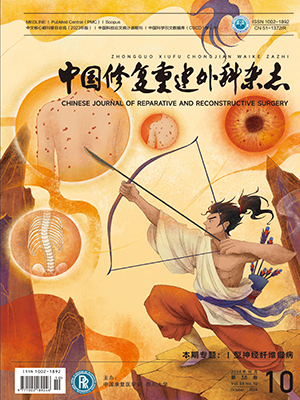Objective To evaluate the effects of in situ subtalar arthrodesis with bone graft for subtalar traumatic arthritis, and to analyse the plantar pressure distribution so as to provide the evidence for effectiveness evaluation. Methods Between March 2004 and December 2008, 26 patients with unilateral subtalar arthrodesis undergoing bone graft fusion were
enrolled (test group). After operation, the imageology diversity and the effect of subtalar arthrodesis on adjacent joint were
observed. American Orthopaedic Foot and Ankel Society (AOFAS) ankle and hindfoot score and radiographs were used to assess the foot function before and after operation. Twenty-six normal subjects served as controls. Footscan system was used to test the distribution of maximum plantar pressure and the change of gravity center curve. No significant difference was found in gender, age, height, and weight between 2 groups (P gt; 0.05). Results All patients were followed up 18.2 months on average (range, 14-71 months). The mean subtalar arthrodesis time was 5.6 months (range, 4 months and 15 days to 11 months). The mean AOFAS ankle and hindfoot score improved from 35.18 ± 8.16 preoperatively to 76.36 ± 6.90 postoperatively (t=13.910, P=0.000). Nine (34.6%) patients had satisfactory functional effects, and 13 (50.0%) patients basically satisfactory. The talocalcaneal height, talocalcaneal angle, talar decl ination angle, and calcaneus patch angle were 87.04% ± 6.17%, 76.73% ± 5.13%, 65.86% ± 7.01%, and 70.19% ± 8.33% of the contralateral side, respectively. Osteoarthritis of the adjacent joints occurred in 7 cases. The maximum plantar pressure increased in the third to fifth metatarsal bones and decreased in the first to second metatarsal bones, showing significant differences when compared with normal controls (P lt; 0.05). No significant difference was found in the plantar pressure between arthrodesis foot and contralateral foot of the test group (P gt; 0.05). The plantar pressure was well distributed in patient who was satisfied with the effect, but it was still different from normal controls. In patients who had high plantar pressure n middle foot, mild heel inversion occurred. The gravity center curve of the contralateral foot in the test group was almost the same as that of normal controls; curve medially shifted when forefoot touched down. The curve irregularly and laterally shifted in the subtalar arthrodesis foot; the curve did not medially shift when forefoot touched down. Conclusion In situ subtalar arthrodesis with bone graft has good cl inical results for subtalar traumatic arthritis. Gait analysis can be appl ied to assess the therapeutic effectiveness, and contribute to make a surgical plan. For the adaptive alteration of contralateral side after subtalar arthrodesis, a cohort of normal subjects should be used for comparison in gait analysis.
Citation: WU Zhanpo,CHEN Wei,ZHANG Qi,YIN Bing,LI Ming,WANG Haili,ZHANG Yingze.. EFFECTIVENESS OF IN SITU SUBTALAR ARTHRODESIS WITH BONE GRAFT FOR SUBTALAR TRAUMATIC ARTHRITIS AND GAIT ANALYSIS. Chinese Journal of Reparative and Reconstructive Surgery, 2011, 25(10): 1205-1209. doi: Copy




